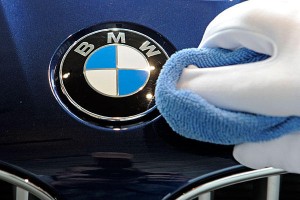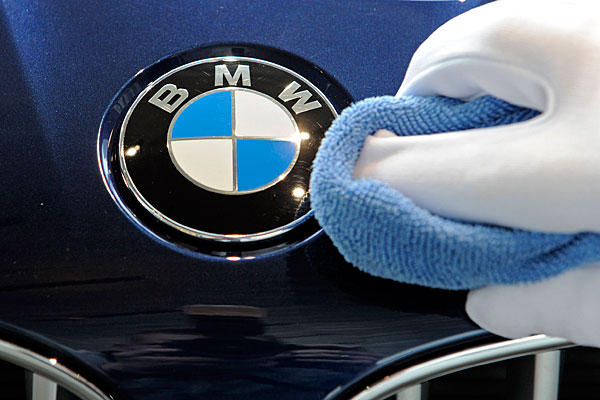 It was a profitable year for BMW, according to 2012 sales reports released to the public from BMW, Daimler AG’s Mercedes-Benz brand and Toyota Motor Corp’s Lexus lines. BMW’s sales were up by 13 percent from the previous year, the brand sold 247,907 vehicles in 2011, while Mercedes-Benz sales were also up by 13 percent, having sold 245,231 vehicles last year. BMW topped both of them and ended Lexus’s 11-year running streak as the best selling luxury car in the U.S. Most luxury lines defied previous sales expectations by outpacing the auto markets 10 percent gain in 2011.
It was a profitable year for BMW, according to 2012 sales reports released to the public from BMW, Daimler AG’s Mercedes-Benz brand and Toyota Motor Corp’s Lexus lines. BMW’s sales were up by 13 percent from the previous year, the brand sold 247,907 vehicles in 2011, while Mercedes-Benz sales were also up by 13 percent, having sold 245,231 vehicles last year. BMW topped both of them and ended Lexus’s 11-year running streak as the best selling luxury car in the U.S. Most luxury lines defied previous sales expectations by outpacing the auto markets 10 percent gain in 2011.
Toyota Camry: MSRP $23,085 – Known much more for its consistently high safety ratings than its style, a 27-year-old suburban home owner who buys a Camry and has a clean driving record can still expect to pay $471 car insurance tab (or $61 per month).
Honda Accord EX: MSRP $30,570 – Few cars seem to be as ubiquitous on the roads in America these days than a silver Honda Accord. Indeed, they seem to be viewed as the model for reliability and efficiency. A 30-year-old single men with a steady job living in a rural community with a clean driving record will about $700 for a six-month policy ($121.40/month).
Ford Focus: MSRP $17,365 – Both relative youth and frequent usage matter. A 22-year-old fresh-faced female salesman who uses her Ford Focus for her job as a saleswoman will pay $208.75 per month, or $1,222.50 for six months of coverage, despite her clean driving record.
Whether you go with a luxury car or not, factors in your profile (age, marital and job status, driving history and frequency) are primarily taken into consideration first before the make-and-model of your vehicle to determine the amount you will be shelling out for auto insurance coverage.
Sources: Allstate, Geico, Edmunds.com
While this is great news for luxury automakers, the purchase of a luxury car can cost you more than just the sticker price at the dealer. While it can sometimes be counter intuitive, you can generally expect to pay significantly higher auto insurance premiums if you own a luxury vehicle
Jeanne M. Salvatore, spokesperson for the Insurance Information Institute (III), says that while make-and-model policies differ depending on company and state, it is always a significant factor in the underwriting process.
“It has a big effect,” Salvatore says. “The choice of car is a major cost driver in that it’s going to affect both comprehensive and collision coverage. Comprehensive covers the car if it is stolen and if you drive a $50,000 car it will cost you more to replace. The cost to repair a more expensive car is much higher because the specialized parts would cost more.”
Collision coverage protects you financially from car accidents and other traffic mishaps if your car hits or is hit by another vehicle or object. Comprehensive coverage, on the other hand, protects you from incidents other than collisions (damage from theft, fire, flood or animals).
Also, according to Salvatore, if you own a larger vehicle and it hits a smaller vehicle there is more of a chance that the person you collide with would be seriously injured or killed.
“It’s an effort to measure the risk as accurately as we can in order to charge each of our customers a premium that is consistent with the risk they are transferring to us,” says Dick Luedke, spokesperson for State Farm.
Consumers can examine make-and-model data on State Farm’s website, gauging each car on four categories: collision, comprehensive, bodily injury and property damage liability premiums (rated A-E), and a vehicle safety discount or (VSD).
A high-end luxury model like Ferrari’s 621 Scaglietti received the worst marks (E or most expensive) on collision and comprehensive premiums, and only paid a VSD of 20 percent. Conversely, a more practical vehicle such as the Chrysler Town & Country Minivan got the highest marks (A or least expensive) on collision and comprehensive premiums and paid a VSD of 40 percent— the highest in the industry.
That’s not to condemn luxury cars as wholly unsafe. As Luedke points out, it is “impossible to make a generic statement. It varies significantly from one make and model to the next.”
Yahoo! Finance offers a top 10 list of most and least expensive cars to insure with comments from Luedke.
 Luxury cars are more expensive to insure for several reasons. First, luxury vehicles are more expensive to replace if totaled based on sticker price alone. Secondly, Luedke notes that it costs more to replace a bumper on a Lexus than on a Ford Focus. Also, the parts for luxury cars cannot be interchanged with aftermarket parts because this may void the warranty.
Luxury cars are more expensive to insure for several reasons. First, luxury vehicles are more expensive to replace if totaled based on sticker price alone. Secondly, Luedke notes that it costs more to replace a bumper on a Lexus than on a Ford Focus. Also, the parts for luxury cars cannot be interchanged with aftermarket parts because this may void the warranty.
Also, the mechanics are so intricate in most luxury cars that the dealership or someone who specializes in high-end luxury vehicles can only repair them. This can add significant cost to the overall repair bill.
Finally, flashy, name-brand cars are (generally) more attractive to car thieves and have a higher theft rate.
State Farm and other car insurance companies keep detailed claims data for every make and model on the road today. They take that information and crunch the numbers based on several categories to determine the rates for each particular make-and-model of car.
“It’s not all about safety, it’s about claims cost,” Luedke says, “We measure which vehicles are better at protecting the occupants of the vehicle, which vehicles are more costly to fix in an accident, which ones inflict more damage on other vehicles when they collide with them, etc. Then we rate accordingly.”
 Auto insurance rates for luxury are not always astronomical. In fact, if you are a safe driver rates can be reasonable. Here are some examples:
Auto insurance rates for luxury are not always astronomical. In fact, if you are a safe driver rates can be reasonable. Here are some examples:
The stigma behind luxury vehicles is that if the sticker price doesn’t kill your wallet, the insurance bill will. But this graph – which compares basic luxury vehicles with more high-end domestic or simple common brands – shows the differences isn’t as drastic as you might think.
Cost Comparison: Luxury High-end vehicle models
BMW 3 Series: MSRP $34,525 – A 20-year-old single, suburban man with a good job and a clean driving record who owns a basic BMW 3-Series (the most popular of the Bavarian autos currently on the market) will pay just $58.34 per month ($320 total) for a six-month policy.
Mercedes-Benz SLK300: MSRP $91,875 – Anytime you own a “Formula 1-inspired roadster” that rockets from 0 to 60 in a mere 5.4 seconds, you can expect to pay a little more in insurance. Still, a 28-year-old divorced homeowner with a good job and a clean driving record will pay $751.30 for six moths of coverage, or $130.22 per month.
Jaguar XJ: MSRP $73,575 – First unveiled in 1968, the XJ series from Jaguar was the last model of the car that had input from Sir William Lyons, the company’s founder. A 40-year-old divorced bank manager with a clean driving record living in an affluent suburb of Chicago and driving an XJ will pay car insurance rates of $78.22 a month, or $439.30 for a six-month term.













